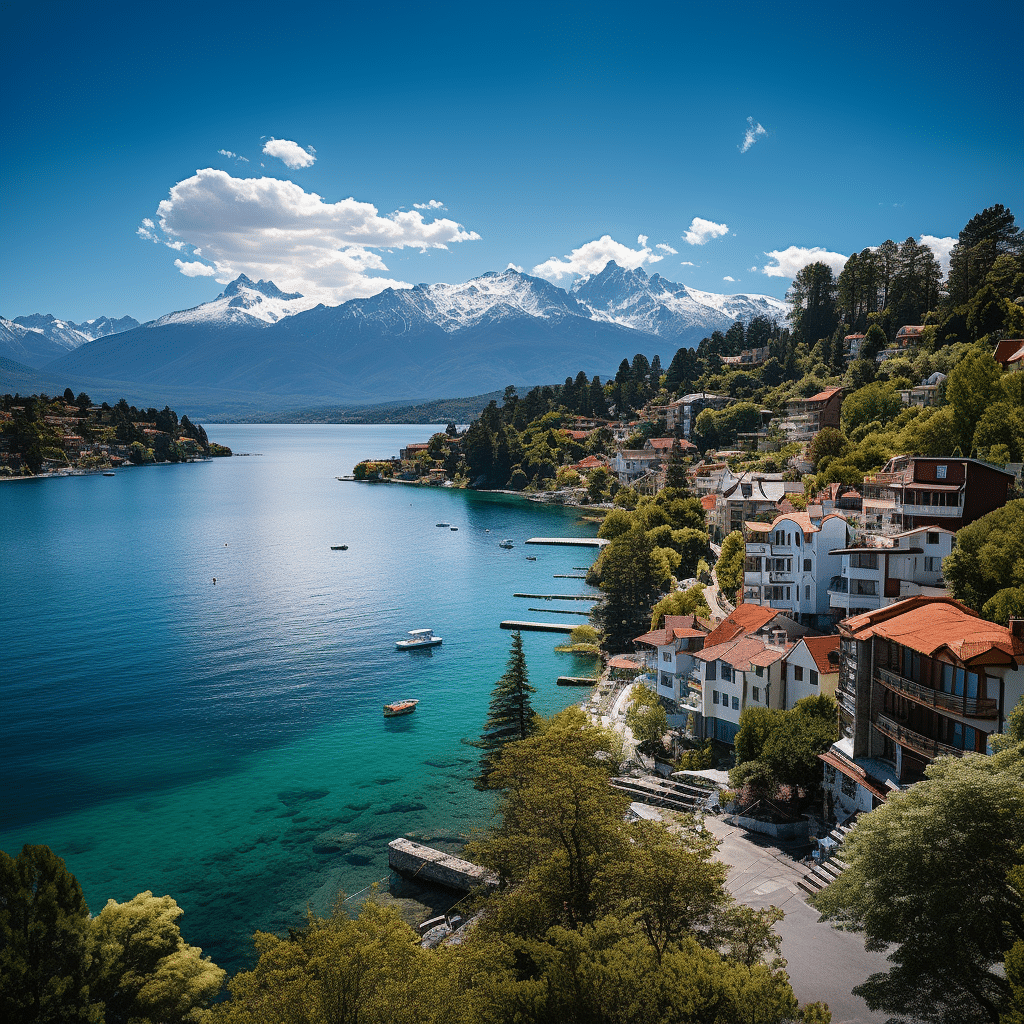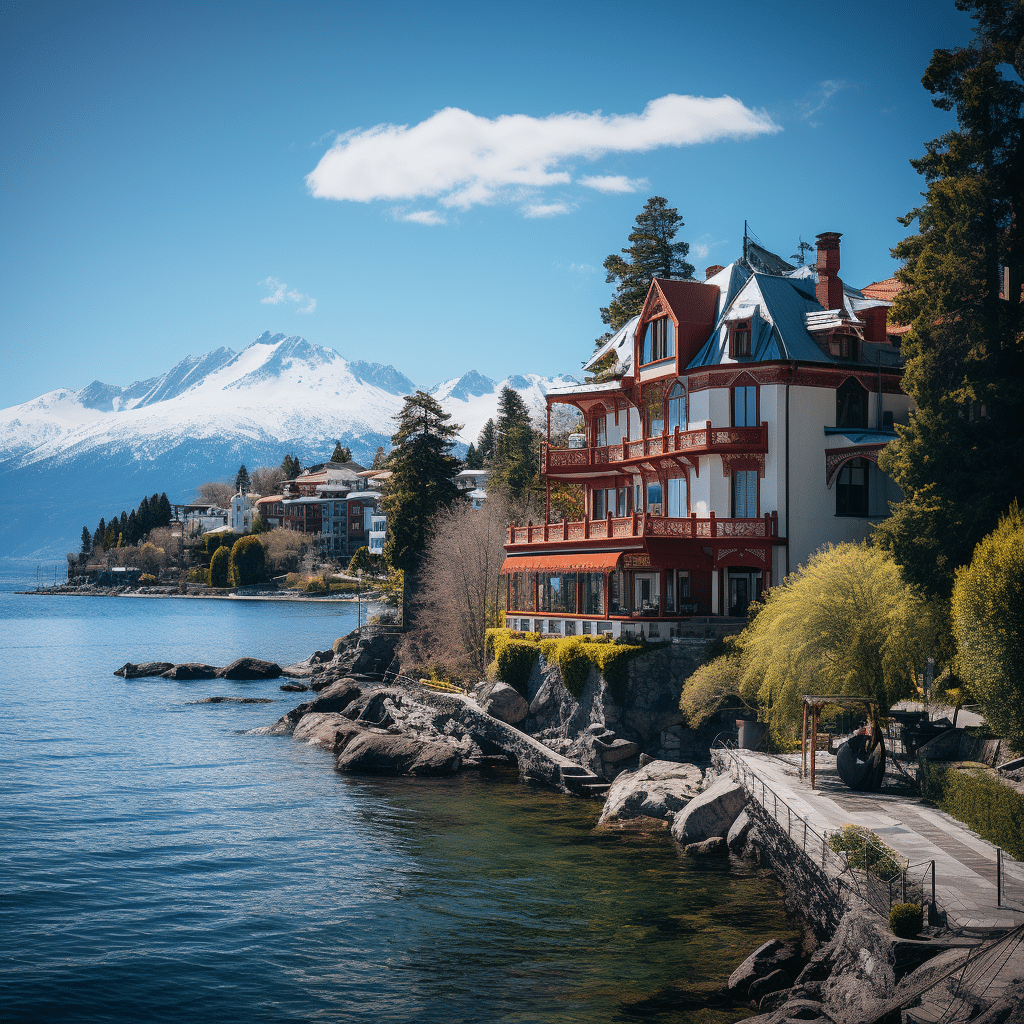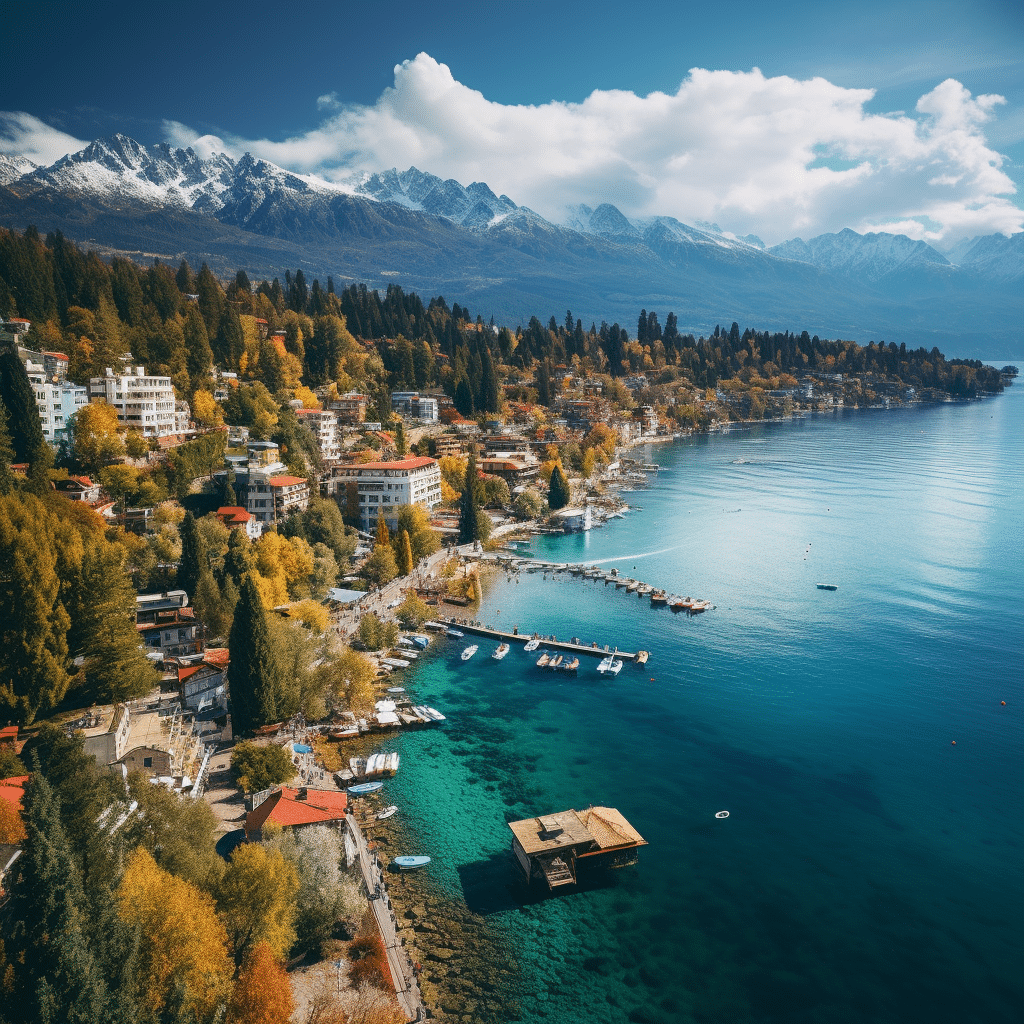Discovering Bariloche: An Untamed Landscape Awaiting
Tucked against the towering Andes and resting by the crystalline shores of Lake Nahuel Huapi, Bariloche possesses an untamed landscape that seems almost too surreal to exist. Bariloche’s unique position within the Patagonian Andes invites travelers into a realm where climates and ecosystems converge in spectacular fashion. Whether you’re basking in the mountain air, wandering through dense forests, or marveling at the serene waters, this adventurous city is year-round bliss for those seeking the extraordinary.
Nature enthusiasts aren’t the only ones drawn to this Argentinian wonderland. Night owls party under the southern stars, chocolate aficionados indulge in world-class sweets, and history buffs explore the past of a community enriched by German descendants. And let’s not shy away from mentioning – if heart-pumping nightlife, a vibrant community, and gastronomical delights are what you seek, then the streets of Bariloche after dusk might just be your slice of heaven.
The Majestic Cerro Tronador: Echoes of Ice and Rock
The Cerro Tronador stands tall — an undeniable beacon of natural grandeur. Looming large at the border between Argentina and Chile, its snowy crown pierces the sky while glaciers cling to its flanks—a timeless tango of ice and stone. The thunderous sounds of falling seracs are the origin of its name, ‘Tronador’, the Spanish word for ‘Thunderer’, offering a natural symphony that heightens the surreal atmosphere.
Bold adventurers thread through stunning trails leading to the base of this colossal giant, stepping into a geological narrative written over millennia. Once there, travelers bear witness to ancient scars latticed across the mountain façade — each crevasse, a tale of earthly forces at play. It is a humbling encounter, one that melds the power of science with the poetry of nature.

| **Aspect** | **Details** |
|---|---|
| Location | San Carlos de Bariloche, Argentine Andes |
| Size | Small city |
| Main Tourism Focus | Adventure travel and night partying |
| Known For | High-quality chocolate, German descendants, year-round destination |
| Cultural History | Sheltered Nazi Erich Priebke (not reflective of current citizens’ views), large German community |
| Educational Facilities | German taught in schools (e.g., Instituto Primo Capraro) |
| Nightlife | Vibrant with nightclubs and pub crawls |
| Outdoor Activities | Skiing, snow-shoeing, trekking; Cerro Catedral (winter months, Apr-Sep) |
| Architecture | Swiss-like |
| Language Origins | Name derived from Mapudungun: Vuriloche (“people from behind the mountain”) |
| Travel from Patagonia | Distance: 417 km (land), 641.5 km (road); Taxi without a car: ~8h 26m, cost: $31000 – $38000 |
| Stay Duration | 7-day stays recommended for full experience |
| Accessibility | Flight from Buenos Aires: ~4h 56m, cost: $60000 – $150000; Bus: ~22h 10m, cost: $15000 – $60000 |
| Notable Views | Picturesque views of surrounding mountains and lakes |
| Seasonal Info | Unusual for Patagonia, offers year-round activities and events |
| Why Visit? | Gateway to Patagonia’s scenery, excellent food & drinks, diverse activities, welcoming community |
| Economic Impact | Tourism is a significant part of the local economy |
| Ideal For | Tourists interested in adventure, culture, history, and nightlife; job seekers with fluency in German |
Lago Nahuel Huapi: The Mirror of the Patagonian Sky
From the snow-capped Cerro Tronador to the reflective surfaces of Lago Nahuel Huapi, nature’s artistry knows no bounds. The lake, brushing against Bariloche like the edge of a vast mirror, captures the majestic visage of the Patagonian sky and the grandeur of the enveloping landscapes. Formed by long-gone glaciers, the lake’s expanse is not merely a body of water, but a cradle of biodiversity and a testament to geological prowess.
Encircled by the Nahuel Huapi National Park, the lake’s waters guard secrets both natural and cultural, its surface a witness to the history unfolding at its shores. Photographers and romantics flock to capture the shifting hues of azure, while environmentalists marvel at the rich tapestry of life beneath the calm horizon. The lake’s appeal transcends its beauty, rooting itself in a heritage that demands both reverence and preservation.
Arrayanes Forest: A Fantastical Walk Through Twisted Trunks
Step into Arrayanes Forest and leave the ordinary world behind. Here, cinnamon barks spiral skyward—a botanical one-off famed as much for its rarity as for the fairy tales it inspires. The forest, a storied sanctuary set on the Quetrihué Peninsula, is accessible by boat from Bariloche or via a tranquil walk from Villa La Angostura, offering a route for every spirit of adventure.
This is not just a grove of trees but a living, breathing creature—a testament to ecological resilience and conservation. As you amble under the twisted canopies, let your imagination meander along with the intertwined branches. Each step uncovers the lace-like intricacies of an ecosystem so delicate and distinctive, it would be no surprise to spot a wood nymph peering from behind the myrtle leaves.

The Seven Lakes Route: A Scenic Drive through Bariloche’s Heart
Winding through the Patagonian landscape, the Seven Lakes Route is not just a drive; it’s an overture to the soul-stirring panorama that is Bariloche. The path leads travelers past Lago Machónico, Lago Falkner, Lago Villarino, Lago Escondido, Lago Correntoso, Lago Espejo, and circles back to the expansive embrace of Lago Nahuel Huapi.
For the uninitiated, each lake dawns as a fresh revelation — watercolors in motion, framed by untouched forests and peaks. The road is a carousel of nature’s finest vistas, lending itself to tent pitches and picnic blankets at every meandering curve. South America’s renown for staggering landscapes is encapsulated here along this route, cementing Bariloche’s reputation as a hub of scenic prestige.
Mount Campanario: A Panoramic Epiphany Above Bariloche
Elevate your senses upon Mount Campanario, where the best views on the planet aren’t just hyperbole; they’re an irrefutable truth. Whether by the pulse of your own stride or the steady climb of a chairlift, reaching the summit is to stand at the gates of panorama paradise. And what awaits is no less than a rapture.
Cast your eyes across the vast panorama: The rugged Andean spine, the profound depths of blue waters, and a tapestry of greenery that weaves through the wild tableau. Here’s where the world seems to pause, inhospitable to all but the most speechless of exclamations. This is where travel transcendence becomes tangible, and you perceive that Bariloche, in all its glory, is a masterpiece best admired from the heavens.
Conclusion: The Endless Allure of Bariloche’s Wonders
To merely pass through Bariloche’s wonders is to graze the surface of a profound encounter. But to surrender to these landscapes is to invite a transformation—envisioning oneself as a note within Earth’s vast symphony. The journey here instills an evocative connection with nature, striking chords of emotion and mindfulness that resonate long after departure.
Bariloche bestows upon its visitors the ultimate luxury of experience — tailor-made for both the valiant of heart and the tranquil soul, wrapping them in the embrace of natural opulence. As we meditate on the region’s magnetic appeal, we’re called upon to partake in safeguarding this living mosaic. For in this corner of Argentina, the whispers of the winds and the wisdom of the waters sing a reminder — to cherish, to protect, and to forever hold dear the silent stories of Earth’s magnificence.
In the end, it’s clear that Bariloche is more than just a destination; it’s a haven of timelessness, a place where luxury travel meets adventurous spirit. From the stained-glass morning skies mirrored in Nahuel Huapi’s surface to the symphonic icefalls of Cerro Tronador, Bariloche awaits those willing to explore the fullness of its splendor. And if your wanderer’s heart yearns for experiences that are as authentic as they are majestic, well, isn’t it time to set eyes and soles on Bariloche and witness its marvels firsthand?
Discovering Bariloche’s Natural Marvels
Nestled in the heart of Argentina’s Patagonia region, Bariloche is nothing short of a treasure trove for nature enthusiasts. This place, oh boy, it’s as if Mother Nature went a tad crazy and threw all her best bits into one spot. From emerald lakes to towering peaks, it’s so stunning you’d probably think you’ve stumbled into a fantasy book illustration!
Unpacking the Magic of Nahuel Huapi
Picture this: crystal-clear waters as far as the eye can see, hugged by snow-dusted mountains. This isn’t your run-of-the-mill lake—it’s Nahuel Huapi, the centerpiece of the region. Rumor has it, ‘packing’ your beach bag tote,( complete with a cozy blanket and some Argentinian snacks, then lounging by the lake is the kind of therapy sessions we all crave. And hey, if it gets chilly, just wrap yourself up like a human burrito and enjoy the view!
Cerro Catedral: The Rockstar of Peaks
Oh, Cerro Catedral, you show-off! Think of it as the Marblehead Massachusetts( of South America—a place where nature’s architecture blows your mind. It’s like the mighty mountains got together, said ‘let’s party’, and Cerro Catedral was born, standing there all majestic.
The Lush Lanes of Los Arrayanes National Park
Who needs a yellow-brick road when you’ve got a forest filled with cinnamon-hued arrayanes trees, right? Some say walking through here is soundtrack-worthy, you might even find yourself humming the Lyrics For Kashmir( by Led Zeppelin ‘cause it feels so otherworldly.
The Cascada de los Cántaros—a Water Symphony
Now this cascading beauty ain’t shy. It’s like she’s yelling ‘look at me!’ and trust me, you’ll want to look. The water cascades down like a melody in nature’s symphony, each tier its own verse. And speaking of verses, don’t go looking for Selena Gomez Nudes,( this cascade is classy and demands full attention on those hypnotic falls.
Piedras Blancas: Snow Sliding Fun
Not just any ole’ hill with snow, Piedras Blancas is a winter wonderland that gives any Barbados Resorts( a ‘run’ for their money, and I mean literally. You can toboggan down this snowy slope faster than you can say ‘frostbite’!
Now, I’m no Sasha Alexander,( but I’d say these sights are on par with the best TV show finales—epic and unforgettable! And sure, while Bariloche doesn’t roll out the red carpet, it rolls out something better—the green carpet of nature in all its glory.
So, you’re probably thinking, ‘Sign me up for this adventure!’ Just remember, if you’re buying property to cozy up next to these wonders, understanding the Co-signer meaning( here is as crucial as bringing your camera to capture those sights!
Alright, folks. That’s the skinny on Bariloche’s natural wonders. Whether it’s a jaunt to a faraway lake or a slide down snow-powdered slopes, this place’s got the magic. With just the right amount of crazy and a whole heap of beauty, Bariloche is the soul-soothing, selfie-taking, awe-inspiring destination your wanderlust has been dreaming about.

Why is Bariloche famous?
Bariloche shines as a famed gem because of its stunning natural beauty, eh? Nestled in Argentina’s Andes, it’s a hotspot for chocolate shops, Swiss-style architecture, and adrenaline-pumping activities like skiing and trekking. No wonder everyone’s buzzing about its crystal-clear lakes and picture-postcard scenery!
Is Bariloche considered Patagonia?
You betcha! Bariloche’s often tossed into the mix when chatting about Patagonia, though it’s technically on the northern edge. Still, it captures all the wild, windswept allure that makes Patagonia the stuff of legend. It’s like, if Patagonia’s the main dish, Bariloche’s the appetizer you can’t resist.
Do they speak German in Bariloche?
Well, hold your horses! While you might catch some German chatter in Bariloche, it’s not the main lingo. Spanish is the star of the show, but thanks to European immigration waves, there’s a neat little German influence in culture and architecture. Achtung, language lovers!
Is it worth going to Bariloche?
Oh, you’re darn tootin’ it’s worth it! Bariloche’s the kind of place that’ll knock your socks off, with its killer combo of outdoor shenanigans and cozy Alpine vibe. Whether it’s hiking, munching on artisanal chocolates, or just soaking up those epic views, there’s something for every wanderer.
Is it walkable in Bariloche?
Sure, Bariloche’s got its share of walkable spots, especially around the Centro Cívico. But let’s be real, with all those hills and the sheer scale of the surrounding nature, your feet might cry uncle! Don’t sweat it though; local buses and cabs can give your soles a break.
What is the most German town in Argentina?
Head over to Villa General Belgrano if you’re hunting for that German vibe in Argentina. It’s like stepping right into Bavaria, with its Oktoberfest shindig and half-timbered buildings. This little slice of Germany is the real McCoy for culture buffs hankering for a Euro fix.
How safe is Bariloche?
Safety in Bariloche? Check! It’s generally a safe bet, with fewer oops-didn’t-see-that-coming moments than big cities. Just keep your common sense cap on for the usual travel no-no’s like pickpockets, and you’ll be golden.
How many days do you need in Bariloche?
For Bariloche, you wouldn’t want to miss a beat, right? So pack in about 3-4 days to truly savor the essence of this outdoor wonderland. That way, you got time for a little bit of this, a little bit of that—mountains, lakes, and choco-lots!
Why is Patagonia so expensive in Argentina?
Alrighty, let’s talk turkey on why Patagonia’s got those sky-high prices. It’s remote, folks—transportation’s pricier, and tourist demand often outstrips supply! And let’s not forget, this ain’t just any place; its off-the-charts beauty means everyone’s willing to pay top dollar.
Why does Argentina have so many Germans?
So, what’s up with the German vibe in Argentina? Back in the day—think late 19th to mid 20th century—Germans found their way to Argentina, setting up shop with waves of other Europeans. They were drawn by the promise of land and a fresh start, and boy, did they leave a footprint!
Do they speak English in Patagonia?
Talking English in Patagonia can be hit or miss. Sure, in touristy spots you’ll nab someone who can gab with you in English, but don’t count on it everywhere. Brush up on your Spanish or arm yourself with a phrasebook—it’s the universal ace up your sleeve!
Is it expensive to live in Patagonia?
If you think Patagonia’s eye-wateringly beautiful, wait till you peek at the cost of living—it’s no walk in the park! Remote locations come with a price tag, from groceries to gas. But hey, for nature this amazeballs, some folks reckon it’s worth every penny.
Can you drink tap water in Bariloche?
Tap water in Bariloche is a go! Most locals drink straight from the tap, and it comes from those pristine mountain streams. Just remember, if your tummy’s a bit on the sensitive side, bottled water’s your friend.
What are the cons of living in Argentina?
Considering a move to Argentina? It’s a mixed bag, buddy. On the one hand, you’ve got scrumptious food, vibrant culture, and passionate soccer games. On the flip side, the economy’s a rollercoaster, and it can be a bureaucratic headache. So, it’s kinda like choosing between steak and inflation—tough call!
Are there mosquitoes in Bariloche?
In Bariloche, mosquitoes should be the least of your worries, pal. Thanks to its alpine climate and cooler temps, these pesky critters don’t usually make the guest list. Instead, you’ll be swatting away pure awe at the stunning views!
























